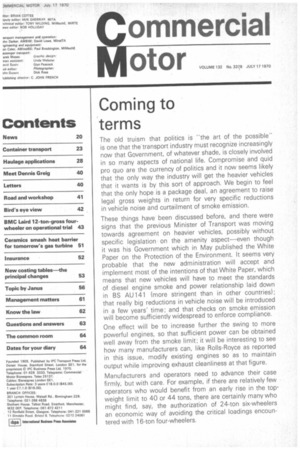Coming to terms
Page 19

If you've noticed an error in this article please click here to report it so we can fix it.
The old truism that politics is -the art of the possible' is one that the transport industry must recognize increasingly now that Government, of whatever shade, is closely involved in so many aspects of national life. Compromise and quid pro quo are the currency of politics and it now seems likely that the only way the industry will get the heavier vehicles that it wants is by this sort of approach. We begin to feel that the only hope is a package deal, an agreement to raise legal gross weights in return for very specific reductions in vehicle noise and curtailment of smoke emission.
These things have been discussed before, and there were signs that the previous Minister of Transport was moving towards agreement on heavier vehicles, possibly without specific legislation on the amenity aspect—even though it was his Government which in May published the White Paper on the Protection of the Environment. It seems very probable that the new administration will accept and implement most of the intentions of that White Paper, which means that new vehicles will have to meet the standards of diesel engine smoke and power relationship laid down in BS AU 141 (more stringent than in other countries); that really big reductions in vehicle noise will be introduced in a few years' time; and that checks on smoke emission will become sufficiently widespread to enforce compliance.
One effect will be to increase further the swing to more powerful engines, so that sufficient power can be obtained well away from the smoke limit: it will be interesting to see how many manufacturers can, like Rolls-Royce as reported in this issue, modify existing engines so as to maintain output while improving exhaust cleanliness at that figure.
Manufacturers and operators need to advance their case firmly, but with care. For example, if there are relatively few operators who would benefit from an early rise in the top. weight limit to 40 or 44 tons, there are certainly many who might find, say, the authorization of 24-ton six-wheelers an economic way of avoiding the critical loadings encountered with 16-ton four-wheelers.








































































































